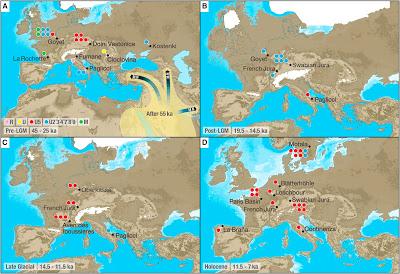Source - http://dienekes.blogspot.fr/
 The fact that UP Europeans had mtDNA haplogroup M really destroys any lingering justification for a coastal migration that first brought (M, N) to Asia and then a subset (N) into Europe.
The fact that UP Europeans had mtDNA haplogroup M really destroys any lingering justification for a coastal migration that first brought (M, N) to Asia and then a subset (N) into Europe.
Another justification for the "Asia-first" model was the presence of Y-haplogroup C in Australians and Asians. But, that too was found in UP Europeans (K14).
So, I think things are looking good for my theory that Eurasians came out of Arabia northwards, interbred with Neandertals, headed both west and east, populating both Europe and Asia. The inferred date for both M and N (55kya) is on the cusp of the 50kya technological transition.
The authors also propose a major turnover in Europe at 14.5kya that replaced (not necessarily completely) the previous occupants. The authors write:
In European hunter-gatherers, our model best explains this period of upheaval as a replacement of the post-LGM maternal population by one from another source. Although the exact origin for this later population is unknown, the inferred demographic history (Figure 3 and 2b in Figure S2) suggests that it descended from another, separate LGM refugium.
Where was this LGM refugium?
Exactly where this new population came from is still unclear, but it seems likely that they came from warmer areas further south. “The main hypothesis would be glacial refugia in south-eastern Europe,” says Johannes Krause at the Max Planck Institute for the Science of Human History in Jena, Germany, who led the analysis.
Current Biology DOI: http://dx.doi.org/10.1016/j.cub.2016.01.037
Pleistocene Mitochondrial Genomes Suggest a Single Major Dispersal of Non-Africans and a Late Glacial Population Turnover in Europe
Cosimo Posth et al.
How modern humans dispersed into Eurasia and Australasia, including the number of separate expansions and their timings, is highly debated [ 1, 2 ]. Two categories of models are proposed for the dispersal of non-Africans: (1) single dispersal, i.e., a single major diffusion of modern humans across Eurasia and Australasia [ 3–5 ]; and (2) multiple dispersal, i.e., additional earlier population expansions that may have contributed to the genetic diversity of some present-day humans outside of Africa [ 6–9 ]. Many variants of these models focus largely on Asia and Australasia, neglecting human dispersal into Europe, thus explaining only a subset of the entire colonization process outside of Africa [ 3–5, 8, 9 ]. The genetic diversity of the first modern humans who spread into Europe during the Late Pleistocene and the impact of subsequent climatic events on their demography are largely unknown. Here we analyze 55 complete human mitochondrial genomes (mtDNAs) of hunter-gatherers spanning ∼35,000 years of European prehistory. We unexpectedly find mtDNA lineage M in individuals prior to the Last Glacial Maximum (LGM). This lineage is absent in contemporary Europeans, although it is found at high frequency in modern Asians, Australasians, and Native Americans. Dating the most recent common ancestor of each of the modern non-African mtDNA clades reveals their single, late, and rapid dispersal less than 55,000 years ago.Demographic modeling not only indicates an LGM genetic bottleneck, but also provides surprising evidence of a major population turnover in Europe around 14,500 years ago during the Late Glacial, a period of climatic instability at the end of the Pleistocene.
http://www.cell.com/current-biology/fulltext/S0960-9822(16)00087-7